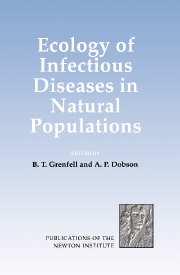Book contents
- Frontmatter
- Contents
- List of Participants
- Introduction
- BROAD PATTERNS AND PROCESSES
- Impact of Infectious Diseases on Wild Animal Populations: a Review
- Microparasites: Observed Patterns
- Mathematical Models for Microparasites of Wildlife
- Microparasite Group Report
- Macroparasites: Observed Patterns
- Mathematical Models for Macroparasites of Wildlife
- Macroparasite Group Report
- Critical Evaluation of Wildlife Disease Models
- PATHOGENS, INSECTS AND PLANTS
- IMPACT OF ECOLOGICAL AND GENETIC HETEROGENEITY
- Glossary
Microparasites: Observed Patterns
Published online by Cambridge University Press: 22 January 2010
- Frontmatter
- Contents
- List of Participants
- Introduction
- BROAD PATTERNS AND PROCESSES
- Impact of Infectious Diseases on Wild Animal Populations: a Review
- Microparasites: Observed Patterns
- Mathematical Models for Microparasites of Wildlife
- Microparasite Group Report
- Macroparasites: Observed Patterns
- Mathematical Models for Macroparasites of Wildlife
- Macroparasite Group Report
- Critical Evaluation of Wildlife Disease Models
- PATHOGENS, INSECTS AND PLANTS
- IMPACT OF ECOLOGICAL AND GENETIC HETEROGENEITY
- Glossary
Summary
Introduction
Microparasites have been broadly defined to include viral, bacterial and protozoan pathogens (Anderson and May 1979). Mathematical models for microparasites characteristically divide the host population into susceptible, infectious and recovered and immune hosts (Anderson and May 1991). This reflects a bias towards studies of microparasites of vertebrates (especially viruses, rather than bacteria and protozoa). In this chapter we review observed epidemiological patterns in the population dynamics of microparasites in free-living animal populations. Many microparasites are characterized by their tendency to produce a sustained immunological response in infected vertebrate hosts; recovered hosts are usually considered to be resistant to further infection. Ecological studies of microparasites in wild animal populations can only occasionally differentiate between the different epidemiological classes within the host population.
More frequently tissue samples have to be collected so that serological tests may be used to differentiate between susceptible and recovered, or resistant animals. Similarly, not all pathogens produce a sustained immunological response, in some cases the pathogen is always fatal (for example, many bacterial and viral infections of invertebrates), in other cases recovered individuals simply re-enter the class of susceptible hosts. Furthermore, it is possible for infected individuals to show no overt symptoms of the disease. In some cases these individuals harbour latent infections which eventually develop and exhibit the characteristic symptoms of the disease in old, malnourished or stressed hosts. In other cases, the infected individuals show no clear symptoms, but are fully capable of transmitting the pathogen to susceptible hosts of the same or another species.
- Type
- Chapter
- Information
- Ecology of Infectious Diseases in Natural Populations , pp. 52 - 89Publisher: Cambridge University PressPrint publication year: 1995
- 25
- Cited by



